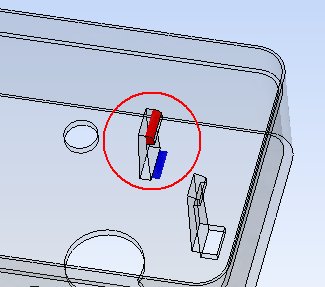The Undercut result displays areas where undercuts are located.
Undercuts are either mistakes in the model – a draft going in the wrong way for example –, or features in the tool that require special tooling components such as sliders, lifters or collapsing cores, in order for the part to be ejected.
Sometimes, if the undercut feature is narrow and the material is very flexible, it is possible to eject the part without special tooling components, for example, with some snap-fits. However, undercuts should be avoided, whenever possible, in order to keep the tool design simple. The less complex the tool is, the less expensive it will be to run and maintain.
Using this result
The Undercut result shows undercuts as well as shadowed features on surfaces that have a draft angle of at least 1 degree.
Once undercuts are detected, the decision can be made to modify the tool design, or to use a more complex tooling component to form the undercut so that the part can be ejected.
When undercuts or shadowed features have been identified on the part, it is necessary to check if these undercuts can be removed from the part design or not. If these features are not necessary, then the part can be redesigned. However, if undercuts are necessary, then tooling components can be designed to ensure a proper ejection of the part.
Removing the undercut or the shadowed feature fixes the problem.
Things to look for
Undercuts are displayed in red, and shadowed areas are displayed in blue. Determine if the undercut is caused by a mistake in the part model, or is necessary for the design intent of the part. If the part contains necessary undercuts, a possible resolution may be to remove shadowed areas or undercut areas from the part. This way, the part can be normally ejected without any major mold changes.
For example, Figure 1. below shows an undercut (red) on a snap finger feature. The shadow is shown in blue. This type of undercut generally requires costly adjustments like the use of a lifter or a slider to ensure the part can be ejected.

Potential undercut problem
However, Figure 2. shows that with a small change and and minimal mold costs a hole can be created in the part to remove where the blue shadowed area would be and then the design becomes valid.

Valid design